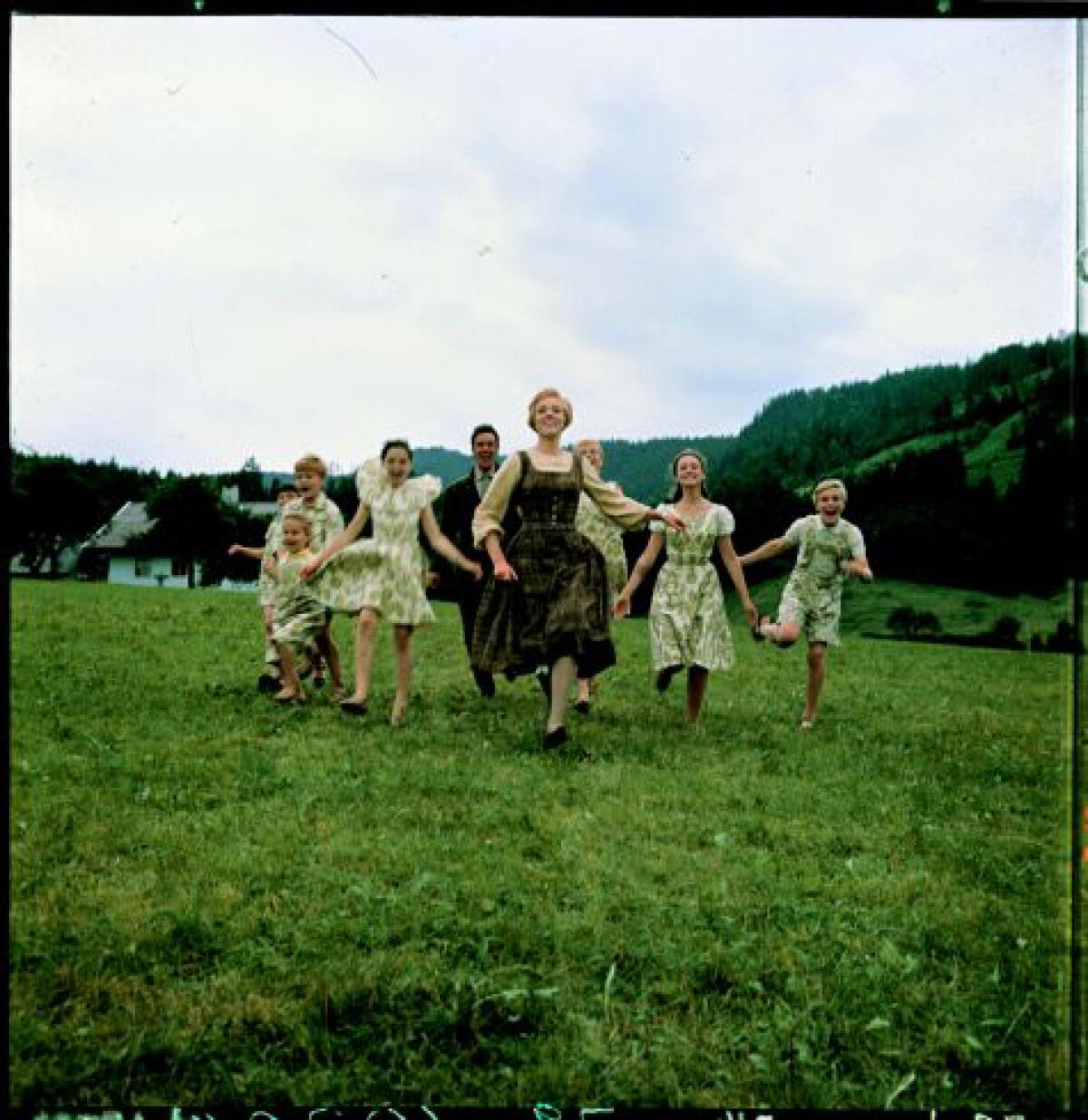From the Archives: ’Sound of Music’ without the taste of saccharine

- Share via
“The hills are alive with the sound of music ... “
Piercing the rolling mists, the camera enters a Grimms’ fairyland of jutting peaks, verdant valleys and castled lakes, floating down and down and stopping at last only when it catches up with Maria, in the sprightly person of Julie Andrews, dancing and singing her heart out and indeed bringing the hills alive.
It is in this magical manner that Robert Wise’s airborne camera approaches fabled Salzburg, just as it descended on the sky-scraping jungles of Manhattan — and another Maria — in “West Side Story.” It is an auspicious, thrilling introduction to “The Sound of Music,” the motion picture, in 70-mm. Todd-AO and DeLuxe Color, which Wise has adapted to the medium from the last of Rodgers and Hammerstein’s stage musicals — again, as with “West Side Story,” with three associates: writer Ernest Lehman, associate producer Saul Chaplin and art director Boris Leven.
Visual, Vocal Brilliance
This time, however, their achievement is greater because the pitfalls were greater. They have taken this sweet, sometimes saccharine and structurally slight story of the Von Trapp Family Singers and transformed it into close to three hours of visual and vocal brilliance, all in the universal terms of cinema. They have invested it with new delights and even a sense of depth in human relationships — not to mention the swooning beauty of Salzburg and the Austrian Alps, which the stage, of course, could only suggest.
They have even made the children palatable.
For their Maria they have Miss Andrews, warmer and more appealing than she was as Mary Poppins and just as irrepressible. If she appears a little old for a postulant, there is no church rule that says she shouldn’t. Opposite her is Christopher Plummer as the mannered and stern (at first) Capt. Von Trapp, whose facial expressions, and particularly the clipped things he does with his jaw, are curiously remindful of Laurence Olivier.
Balanced Cast
The other principals, in a beautifully balanced cast, are Eleanor Parker, looking gorgeous as the too-eligible baroness; Richard Haydn as the sponging, cynical Max Detweiler; Peggy Wood as the mother abbess, and the two young romantics — Charmian Carr as Liesl, the oldest Von Trapp girl, and Daniel Truhitte as Rolfe, her Hitler Youth friend. Plus, of course, the other children, clear down to mind-of-her own Gretl (Kym Karath).
Miss Andrews, naturally, does her own singing — and how. And so does Marni Nixon as Sister Sophia. Otherwise it is anyone’s guess, since the picture follows the usual Hollywood convention of dubbing in all voices that may not measure up to the acting attributes. I don’t say this critically — particularly of a fairy tale that is striving for superhuman perfection — but rather in parenthetical admiration of the movie’s makers for the endless hours they must have put in, note by note and syllable by syllable, to sustain the matching and the illusion.
Another Hurdle Cleared
Another hurdle they have surmounted superbly is the always potentially ticklish lead-in from talk to song — the delicate line between the likely and the absurd, as when the mother abbess, trying to persuade Maria to return to the Von Trapps, faces the captain she has grown to love and “look for your life,” suddenly lifts her deep contralto voice in “Climb Ev’ry Mountain.”
Two new songs have been contributed by Richard Rodgers — Maria’s “I Have Confidence in Me” and the exquisitely directed love duet, bathed in twilight tones, “I Must Have Done Something Good.” These replace, I believe, the stage’s “How Can Love Survive?,” “No Way to Stop It” and “An Ordinary Couple.”
Still intact and, of course, falling nostalgically on the ear are “Maria,” “Sixteen Going on Seventeen,” “Edelweiss,” the yodeling “Lonely Goatherd,” “My Favorite Things” (though in a different connotation) and the contrapuntal and ingenious “Do-Re-Mi” (how happily coincidental that there just happen to be seven children — and Maria — to sing the full octave!).
Handsome Choreography
Besides the stunning opening sequence from the air, others to be cherished by the memory include the whirlwind dance of Liesl and her Rolfe in the summerhouse during a thunderstorm, reminiscent of Natalie Wood’s and Richard Beymer’s mesmerized vis-a-vis in the gym in “West Side Story”; the sparkling montages in which Maria takes the kids on a picture-postcard tour of the city and countryside, and an enchantingly droll presentation of “The Lonely Goatherd” as devised by puppeteers Bil and Cora Baird.
The dancing by people was choreographed handsomely by Marc Breaux and Dee Dee Wood.
Wise makes what could have been a too-abrupt shift from sentiment and fun to melodrama — with the Nazis closing in on the Von Trapps — suspenseful without being painful. It is underplayed and soon over.
High among the credits belong Ted McCord for cinematography (Paul Beeson, second unit), music supervision by Irwin Kostal, costumes by Dorothy Jeakins and film editing by William Reynolds.
While I still regard the composers “South Pacific” as superior musically — it was also filmed by 20th — this one surpasses it artistically. Its sound will ring out for a long time to come. The local premiere takes place Thursday at the Fox Wilshire.
More to Read
The biggest entertainment stories
Get our big stories about Hollywood, film, television, music, arts, culture and more right in your inbox as soon as they publish.
You may occasionally receive promotional content from the Los Angeles Times.










